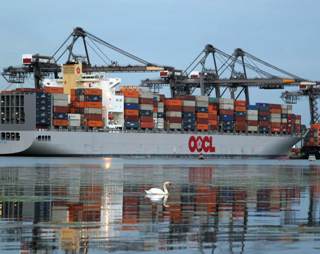 Hong Kong-based Orient Overseas (International) Ltd (OOIL) said today its profit in 2013 nosedived to US$47 million, down from $295.4 million in 2012, as it struggled in a shipping environment last year marked by muted demand and over capacity.
Hong Kong-based Orient Overseas (International) Ltd (OOIL) said today its profit in 2013 nosedived to US$47 million, down from $295.4 million in 2012, as it struggled in a shipping environment last year marked by muted demand and over capacity.
Revenue dropped to $6.2 billion from $6.5 billion in 2013.
“Seaborne trade growth for the liner industry was subdued in 2013,” said OOIL chairman C C Tung. “Freight levels were disappointing, especially during the first half of the year. During the second half of the year, both physical cargo movement and sentiment improved, resulting in a slightly better freight market.”
Despite challenging market conditions, OOIL’s container transport and logistics business reported EBIT (earnings before interest and taxes) of $75.1 million, “representing a competitive margin within the industry,” according to an official company statement.
Although container shipping demand grew more slowly in 2013 than earlier forecasts, capacity growth was also lower than forecasts, helping contribute to a mild recovery in rates during the second half of the year.
Tung said newbuilding deliveries in 2013 reached a record high of nearly 1.4 million TEU (20-foot-equivalent units) in total tonnage.
“After scrapping of older tonnage totaling around 440,000 TEU in 2013, overall global capacity supply grew 5.7 percent in the market, against a global cargo demand growth of 4.2 percent,” he added.
With the largest newbuildings being deployed to the Asia-Europe trade, it triggered cascading into the trans-Pacific trade, which further displaced a considerable number of mid-sized ships to other trade lanes.
“This cascading effect brought considerable excess capacity to the intra-Asia and Australasia trades as well as the trans-Pacific trade, and added volatility to the market,” Tung continued.
OOCL, the group’s container shipping line, increased its total liftings in the fourth quarter by 10 percent from the same quarter of the previous year, overcoming the lifting decline during the early parts of 2013.
Overall, 2013 annual volume rose 1.5 percent year-on-year. Rates, however, were “highly volatile and impacted by the surplus capacity,” Tung stated.
During the year, the group took delivery of two 8,888-TEU new vessels, as well as eight 13,208-TEU new vessels—currently the largest container ships operated by the group.
Two remaining 13,208-TEU newbuildings are to be delivered this year, and four 8,888-TEU newbuildings in 2014 and 2015. No new orders were placed in 2013.
The larger and more efficient newbuildings are expected to make an impact in 2014, reducing unit costs and improving margins, Tung said.
On container shipping, he anticipates further tonnage growth leading to continued over capacity. Still, the demand growth in 2014 will outpace that of 2013, as the United States and Eurozone continue their economic recovery, he predicts.
“A healthier trade outlook should be expected despite recent uncertainty on emerging markets. This is especially true on the major East-West trades. Indeed, such development should mean improved outlook for the trans-Pacific, Asia-Europe and intra-Asia trades and more positive results for the industry as a whole.”
He was more optimistic about prospects in logistics operations for the year, saying the business would be strengthened, particularly the areas of international supply chain and import/export services, and domestic transportation and warehousing services.
“The footprint of this business has grown to 130 offices in 30 countries. It is expected that the logistics business will become a meaningful contributor to the group over the long term,” Tung added.




